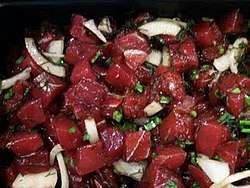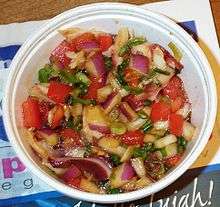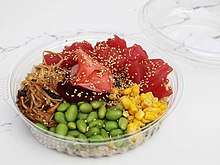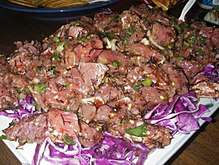Poke (Hawaiian dish)
 | |
| Type | Salad |
|---|---|
| Course | Appetizer |
| Place of origin | United States[1][2] |
| Region or state | Hawaii[1][2] |
| Main ingredients | Yellowfin tuna, sea salt, soy sauce, inamona, sesame oil, limu seaweed, chili pepper |

Poke /poʊˈkeɪ/ (Hawaiian for "to slice" or "cut crosswise into pieces"[3][4]; sometimes stylized Poké[5][6][7] to aid pronunciation) is diced raw fish served as either an appetizer or as a main course and is one of the main dishes of Native Hawaiian cuisine. Traditional forms are aku (an oily tuna) and he'e (octopus). He'e (octopus) poke is usually called by its Japanese name "Tako" Poke, except in places like the island of Ni'ihau where the Hawaiian language is spoken. Increasingly popular ahi poke is generally made with yellowfin tuna. Adaptations may feature raw salmon or various shellfish as a main ingredient served raw with the common "poke" seasonings.[8]
History
The traditional Hawaiian poke consists of fish that has been gutted, skinned, and deboned. It is sliced across the backbone as fillet, then served with traditional condiments such as sea salt, candlenut, seaweed, and limu.[9]
According to the food historian Rachel Laudan, the present form of poke became popular around the 1970s. It used skinned, deboned, and filleted raw fish served with Hawaiian salt, seaweed, and roasted, ground kukui nut meat. This form of poke is still common in the Hawaiian islands.[2]
Beginning around 2012, poke became increasingly popular in the mainland United States.[10] A number of poke restaurants—mostly but not exclusively fast casual restaurants—became popular.[11] [12] From 2014 to mid-2016, "the number of Hawaiian restaurants on Foursquare, which includes those that serve poke," doubled, going from 342 to 700.[10] These restaurants have been creating traditional as well as unique, modern versions of the dish. These variations can include avocado, ponzu sauce, teriyaki sauce, mushrooms, crispy onions, pickled jalapeño, sriracha sauce, cilantro, pineapple or cucumber. The contemporary poke restaurants are mainly fast casual style places where the dish is fully customizable from the base to the marinade on the fish. They may use other seafood but ahi tuna is the most popular. There is a three-day "I Love Poke" festival to celebrate the dish and its many variations.[13] On the mainland, the style of poke prepared is typically different than traditional Hawaiian poke. Notably the mainland style is usually not pre-marinated, instead prepared with sauces on demand, and is often differentiated by using the non-traditional spelling of "poké" with the e-acute letter é.
Ingredients
Poke began with fishermen seasoning the cut-offs from their catch to serve as a snack.[9] Traditional poke seasonings have been heavily influenced by Japanese and other Asian cuisines. These include soy sauce, green onions, and sesame oil. Others include furikake (mix of dried fish, sesame seeds, and dried seaweed), chopped dried or fresh chili pepper, limu (seaweed), sea salt, inamona (roasted crushed candlenut), fish eggs, wasabi, and Maui onions. Other variations of poke may include cured heʻe (octopus), other types of raw tuna, raw salmon and various kinds of shellfish.[8]
Traditional Hawaiian poke may consist of cubed raw fish, maui onions, Inamona (a condiment made of roasted, salted candlenut), Limu (algae), soy sauce, green onions, or sesame oil.[14]

Similar dishes

Raw fish dishes similar to poke that are often served in Europe are fish carpaccio and fish tartare. Also similar to poke are Korean hoedeopbap, marinated raw tuna served over rice, and Peruvian ceviche. Japanese sashimi also consists of raw seafood; other similar Japanese dishes are zuke don, a donburi dish topped with cured fish (usually tuna or salmon) along with avocado topped with furikake, and kaisendon, a more elaborate version served with additional non-fish toppings.
See also
References
- Titcomb, Margaret (1972). Native use of fish in Hawaii (2nd ed.). Honolulu, Hawaii: University of Hawaiʻi Press. ISBN 9780870227974. OCLC 309517.
- 1 2 Matt Dean Pettit (10 April 2018). The Great Shellfish Cookbook: From Sea to Table: More than 100 Recipes to Cook at Home. Appetite by Random House. p. 161. ISBN 978-0-14-753058-5.
- 1 2 3 Laudan, Rachel (1996). The Food of Paradise: Exploring Hawaii's Culinary Heritage. University of Hawaii Press. pp. 37–38. ISBN 9780824817787. Retrieved 2017-01-28.
- ↑ Martha Cheng (24 January 2017). The Poke Cookbook: The Freshest Way to Eat Fish. Potter/Ten Speed/Harmony/Rodale. pp. 7–8. ISBN 978-0-451-49807-6.
- ↑ Mary Kawena Pukui and Samuel Hoyt Elbert (2003). "lookup of poke". in Hawaiian Dictionary. Ulukau, the Hawaiian Electronic Library, University of Hawaii Press.
- ↑ Noguchi, Mark. "A Conflicted Chef From Hawaii Reacts to the Mainland Poke Bowl Trend". First We Feast. Retrieved 11 June 2018.
- ↑ Tan, Rachel. "6 Things To Know About Hawaiian Poke". Michelin Guide. Retrieved 11 June 2018.
- ↑ Cheng, Martha. "How the Hawaiian poke bowl became the world's new fast food". Hawai'i Magazine. Retrieved 11 June 2018.
- 1 2 "Make Hawaii-style ahi poke wherever you are. Here's a recipe". Hawaii Magazine. Retrieved 2015-11-24.
- 1 2 "Hawaiian Ahi Tuna Poke Recipe and History, How To Make Poke, Whats Cooking America". whatscookingamerica.net. Retrieved 2015-11-24.
- 1 2 Vince Dixon, Data Dive: Tracking the Poke Trend: Proof that the Hawaiian dish is here to stay, Eater (September 14, 2016).
- ↑
- Catherine Smart, The Hawaiian raw-fish dish poke is having a moment, Boston Globe (December 27, 2016).
- Laura Hayes, What Does a Hawaii-Born Chef Think of D.C.'s Poke Craze?, Washington City Paper (April 13, 2017).
- Jay Jones, Hawaii's endless poke craze, stoked by new twists and traditional dishes, Los Angeles Times (May 12, 2016).
- Hillary Dixler, Can Poke Be the Next Fast-Casual Trend? Why restaurateurs are building brands around the Hawaiian staple, Easter (January 22, 2016).
- ↑ Fabricant, Florence (2016-01-26). "Poké, a Hawaiian Specialty, Emerges in Chelsea". The New York Times. ISSN 0362-4331. Retrieved 2017-05-05.
- ↑ Stradley, Linda (2015-05-16). "Hawaiian Ahi Tuna Poke Recipe, Whats Cooking America". What's Cooking America. Retrieved 2017-05-04.
- ↑ Namkoong, Joan (2001-01-01). Go Home, Cook Rice: A Guide to Buying and Cooking the Fresh Foods of Hawaiʻi. Bess Press. ISBN 9780964335929.
External links
| Wikimedia Commons has media related to Poke (Hawaii). |
